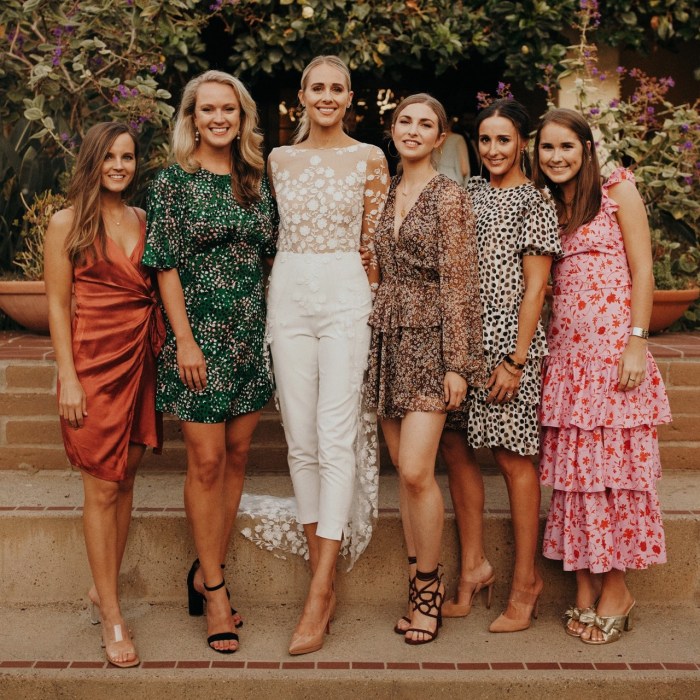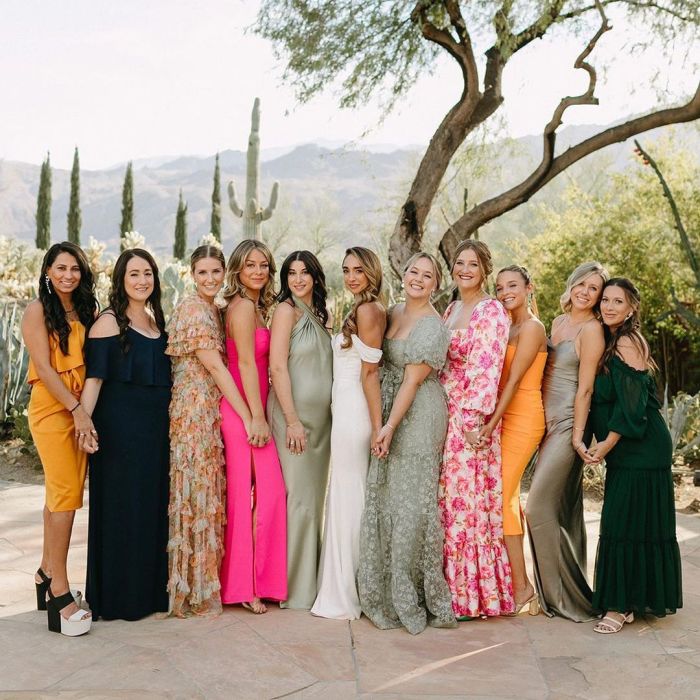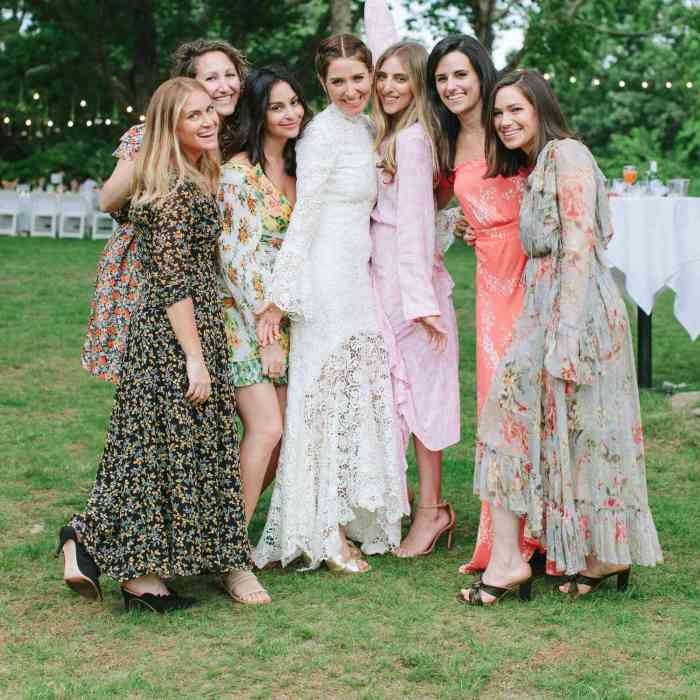Guests Dresses for Weddings A Style Guide
Wedding Guest Dress Styles
Guests dresses for weddings – Choosing the right dress as a wedding guest requires careful consideration of several factors, including the wedding’s formality, venue, and season. Understanding current trends and etiquette ensures you’re appropriately dressed and feel confident celebrating the happy couple.
Popular Wedding Guest Dress Styles in 2024
Current trends favor versatile styles that blend elegance and comfort. Midi and maxi dresses remain popular choices, offering a range of silhouettes suitable for various body types. A-line dresses flatter most figures, while fit-and-flare styles offer a more defined waist. Wrap dresses are another excellent option, providing a flattering and adjustable fit. Details like ruffles, puff sleeves, and subtle embellishments add a touch of sophistication without overpowering the overall look.
Formal, Semi-Formal, and Casual Wedding Attire
The formality of the wedding dictates the appropriate dress code. Formal weddings call for floor-length gowns in luxurious fabrics like silk or velvet. Semi-formal events allow for midi dresses, cocktail dresses, or elegant jumpsuits in materials such as chiffon or crepe. Casual weddings offer more flexibility, with knee-length dresses, sundresses, or even stylish separates being acceptable choices.
Fabric Choices for Different Seasons

Source: greenweddingshoes.com
Fabric selection is crucial for comfort and appropriateness. Lightweight fabrics like cotton, linen, and silk are ideal for summer weddings, ensuring breathability in warmer weather. For winter weddings, heavier fabrics such as velvet, brocade, or wool provide warmth and elegance. Consider the venue’s climate when choosing your fabric.
Neckline Styles for Wedding Guest Dresses
The neckline of a dress significantly impacts the overall look. Different necklines suit various body types and personal styles. The following table provides examples of popular neckline styles:
| Neckline Style | Description | Suitable Body Type | Example Dress Style |
|---|---|---|---|
| V-Neck | Elongates the neck and torso. | Most body types | A-line dress, wrap dress |
| Round Neck | Classic and versatile. | Most body types | Shift dress, fit-and-flare dress |
| Sweetheart Neckline | Romantic and flattering. | Most body types | A-line dress, empire waist dress |
| Off-the-Shoulder | Stylish and contemporary. | Most body types | Maxi dress, midi dress |
Color Choices for Wedding Guest Dresses
Color selection is vital; it impacts the overall aesthetic and adheres to wedding etiquette. Certain colors are traditionally avoided, while others complement different skin tones and wedding themes.
Appropriate and Inappropriate Color Choices
Avoid wearing white or ivory, as these are typically reserved for the bride. Bright, bold colors can sometimes be too distracting, depending on the wedding’s theme and venue. Subdued and elegant colors are generally preferred. Consider the wedding’s color palette to ensure your dress complements, rather than clashes with, the overall aesthetic.
Impact of Color on Overall Look
Color significantly influences the perception of a dress. Darker colors, such as navy, emerald green, or burgundy, create a sophisticated and elegant look, while pastel shades project a softer, more romantic feel. Bright colors can add vibrancy and personality, but should be chosen thoughtfully.
Colors Complementing Various Skin Tones
Warm skin tones often look best in earthy tones like olive green, burnt orange, or deep reds. Cool skin tones tend to favor blues, purples, and jewel tones. Experiment with different colors to find what flatters your complexion best. Neutral colors like navy, gray, or black are universally flattering.
Color Palettes for Different Wedding Settings
A beach wedding might suggest a light and airy palette of blues, whites, and corals. A garden wedding could incorporate soft pastels like lavender, mint green, and blush pink. A ballroom wedding might call for richer tones, such as emerald green, sapphire blue, or ruby red. The setting should guide your color choices.
Accessorizing Wedding Guest Dresses
Accessories elevate a wedding guest dress, adding personality and enhancing the overall look. Careful selection complements the dress and the wedding’s theme, creating a cohesive and stylish appearance.
Key Accessories to Enhance a Wedding Guest Dress
Jewelry, handbags, and shoes are key accessories. Delicate necklaces, earrings, and bracelets can add a touch of elegance. A clutch or small handbag is practical and stylish. Shoes should complement the dress and be comfortable enough for dancing.
Jewelry for Various Dress Styles

Source: greenweddingshoes.com
Simple jewelry complements elaborate dresses, while bolder pieces can enhance a simpler dress. Statement necklaces work well with high-necked dresses, while dangling earrings suit dresses with lower necklines. Match the metal of your jewelry to other accessories for a cohesive look.
Matching Accessories to Dress and Theme, Guests dresses for weddings
Consider the wedding’s theme when choosing accessories. A rustic wedding might call for natural materials like wood or leather, while a glamorous wedding could inspire more sparkly or metallic accessories. Ensure the accessories complement the dress’s color and style.
Accessories for Different Formality Levels
Formal weddings call for more elegant accessories, such as pearl necklaces or delicate diamond earrings. Semi-formal events allow for slightly more playful accessories, while casual weddings offer more freedom in choice. Always prioritize comfort and appropriateness.
Finding the Perfect Wedding Guest Dress: Guests Dresses For Weddings
Finding the perfect dress involves considering various factors, including budget, personal style, body type, and the wedding’s dress code. A strategic approach ensures you find a dress that makes you feel confident and comfortable.
Shopping for Wedding Guest Dresses
Numerous options exist for purchasing wedding guest dresses. Online retailers offer vast selections and convenience, while brick-and-mortar stores provide the opportunity to try dresses on and receive personalized assistance. Department stores, boutiques, and specialty stores all offer unique selections.
Factors to Consider When Choosing a Dress
Budget is a primary consideration. Personal style influences the choice of silhouette, color, and details. Body type should inform the selection of a flattering silhouette and neckline. The wedding’s dress code dictates the level of formality and appropriateness.
Determining Dress Length and Silhouette
Dress length should align with the wedding’s formality. Silhouette selection depends on body type. A-line dresses flatter most figures, while empire waist dresses are suitable for various body types. Consider your personal preferences and comfort level.
Step-by-Step Guide to Selecting a Wedding Guest Dress
1. Determine the wedding’s dress code and venue. 2. Set a budget. 3.
Consider your personal style and body type. 4. Shop online or in stores. 5. Try on several dresses.
6. Choose a dress that is comfortable, flattering, and appropriate for the occasion. 7. Accessorize thoughtfully.
Wedding Guest Dress Etiquette
Adhering to wedding guest dress etiquette ensures respect for the couple and contributes to a positive atmosphere. Understanding unspoken rules and guidelines ensures you’re appropriately dressed and avoid any potential faux pas.
Essential Etiquette Guidelines

Source: brides.com
Choosing the right attire for a wedding as a guest can sometimes feel tricky. While many vibrant colors are appropriate, a sophisticated option is a formal black dress, especially for evening events. For those considering this elegant choice, a great resource for inspiration is this website dedicated to formal black dresses for weddings. Ultimately, the key is selecting a dress that is respectful to the wedding’s formality and reflects your personal style.
Avoid wearing white or ivory, as these colors are traditionally reserved for the bride. Consider the wedding’s venue and time of day. Choose a dress that is appropriate for the level of formality. Ensure your dress is clean, well-fitting, and in good condition.
Importance of Venue and Time of Day
An outdoor wedding may call for a lighter, more casual dress, while an indoor, formal wedding requires a more elegant outfit. A daytime wedding generally calls for less formal attire than an evening wedding.
Unspoken Rules Regarding Dress Length, Style, and Color
Dress length should be appropriate for the venue and time of day. Avoid overly revealing or attention-grabbing styles. Choose colors that are complementary to the wedding’s theme and avoid clashing with the bride’s dress.
Examples of Inappropriate Dresses
Wearing a dress that is too revealing, overly casual, or clashes dramatically with the wedding’s theme would be considered inappropriate. Similarly, wearing a dress that is overly similar to the bride’s attire would be disrespectful.
Detailed FAQs
Can I wear a jumpsuit to a wedding?
Yes, jumpsuits can be a stylish and appropriate choice, particularly for less formal weddings. Choose a sophisticated style in an appropriate color and fabric.
What if I don’t know the dress code?
If unsure, contact the couple or a close friend to inquire about the dress code. A semi-formal or cocktail dress is usually a safe bet.
What length dress is most appropriate?
Generally, knee-length or midi dresses are versatile choices for most weddings. Avoid overly short or excessively long dresses.
Are there any colors I should avoid?
It’s generally advisable to avoid wearing white or shades too close to the bride’s dress color. Bright red can also be considered bold and might be best avoided.



















